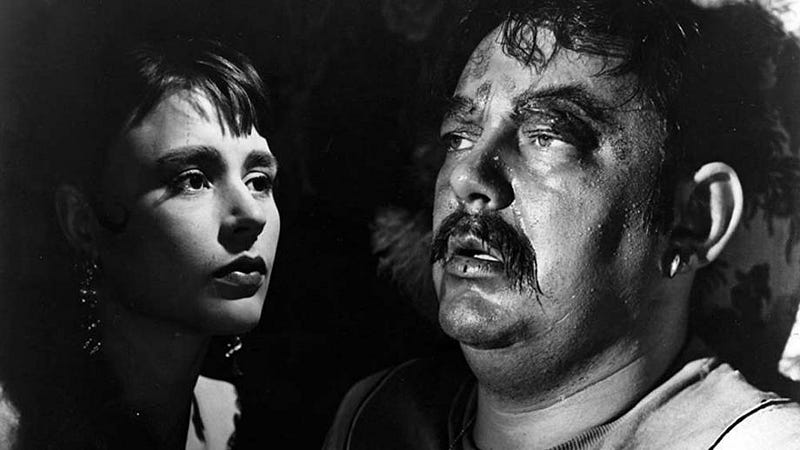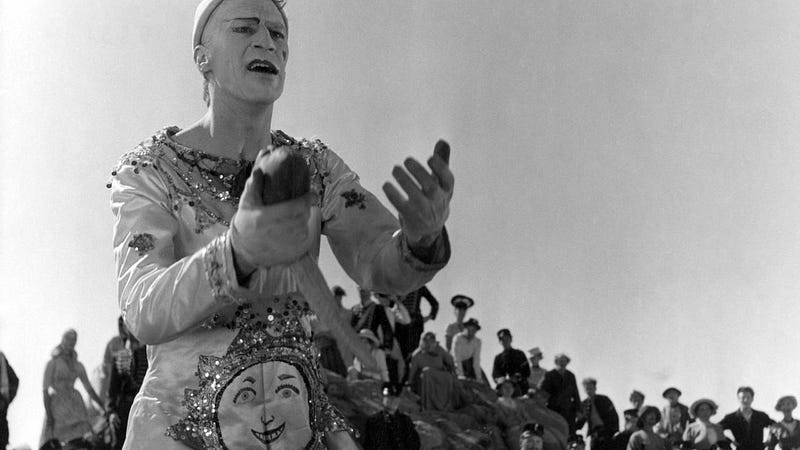Power plays and degradation under the circus big top

If you can’t (or won’t) splurge on the magnificent Ingmar Bergman’s Cinema set Criterion released last month, you can celebrate the fact that they’re continuing to put out individual releases. After previously covering Scenes from a Marriage and The Virgin Spring, next up is 1953’s Sawdust and Tinsel, originally released stateside as The Naked Night. One of Bergman’s earlier films, it shows the roots of many of the themes that he would explore heavily in his later work.
Synopsis:
Ingmar Bergman presents the battle of the sexes as a ramshackle, grotesque carnival of humiliation in Sawdust and Tinsel, one of the master’s most vivid early works and his first of many collaborations with the great cinematographer Sven Nykvist. The story of the charged relationship between a turn-of-the-twentieth-century circus owner (Åke Grönberg) and his younger mistress (Harriet Andersson), a horseback rider in the traveling show, the film features dreamlike detours and twisted psychosexual power plays, making for a piercingly brilliant depiction of physical and spiritual degradation.

The circus is coming to town. Led by Ringmaster Albert Johansson (Ake Grönberg), they arrive in a small Swedish village that holds many memories for the man, being the place where he previously abandoned his wife Agda (Annika Tretow) and their two kids. Life on the road has taken its toll, dreams have been dashed, and he contemplates reconciling with the life he left behind. But this visit brings more strife as well as driving home the idea that you can’t go back again. At his side is his current partner Anne (Harriet Andersson), a young aspiring actress, insecure about the prospect of Albert reuniting with his family. Expressing this, he reaches out anyway, leaving Anna susceptible to her feelings of rejection, vulnerability, and the charms of local lothario Frans (Hasse Eckman), who maneuvers the situation to his own advantage, while further fueling the humiliation of Albert.
It’s a well-orchestrated scenario, replete with situations for various character studies. Set against the surreal backdrop of early 1900s Sweden, we visit this traveling big top and the denizens within. Life on the road has not been kind, leading to contemplation of the path not traveled for Albert. A man who is clearly invested in his own interests, he is carrying the shame of leaving his family behind, his position within the circus undermined by the lack of success and being looked down upon by real performers, a theater group. Even his own people subject him to scrutiny for his behavior. He has a girlfriend, Anne, who is with him not out of love but necessity. His career and way of life cause him to yearn for his old one as a shopkeeper, husband, and father. Compounding things is how his wife and children have done quite well in his absence, and his return rebuffed, adding to his humiliation, while also fracturing his relationship with Anne.
Sawdust and Tinsel certainly has a warped sensibility, and much of this comes from the dynamics and settings. Often dark in tone, there is a bleakness to proceedings that comes from the futility of the endeavors of Albert and co., efforts to take back what has been said or done, or avoid further degradation and pain. The early 1900 setting lends well to ornate compositions; circus aesthetics, makeup, and elaborate routines and costumes give the whole things a surreal vibe, one amplified by cinematographer Sven Nykvist, who would go on to have a long and successful collaboration with Bergman. Grönberg stands out as this weary circus master. Andersson too, with her portrayal as a timid soul trying to play the game, and falling afoul herself. Anders Ek and Gudrun Brost also stand out as a husband and wife who hold Albert to even more scrutiny. These characters are all dealing with issues past and present. Rejection and betrayal, failure and embarrassment. The dynamics, notably focused around gender and control, or personal and professional success, make for a engrossing study. One that verges on the masochistic at times, but is always rooted in a raw truth.

The Package
Older black and white films always highlight a variety of sins when it comes to hi-def releases, a challenge Criterion usually rises to with aplomb. They do so yet again with this Blu-ray. A sharp and detailed transfer showcases deep blacks and impressive contrast. The film looks natural, not artificially processed, maintaining a natural grain and character. Special features are a little thin on the ground compared to some Criterion releases, but still of good quality:
- Introduction: Presented here is a vintage introduction to Sawdust and Tinsel, which Ingmar Bergman recorded for journalist Marie Nyrerod in 2003. In Swedish, with optional English subtitles.
- Commentary — archival audio commentary recorded by film scholar and author Peter Cowie for Criterion’s 2007 DVD release of Sawdust and Tinsel: A deep dive into various aspects of the film, the seeds for themes and ideas that populate his latter filmography, and with a notable focus on the burgeoning relationship between Bergman and his cinematographer Nyqvist. He also touches on some of the more negative reception the film encountered upon its original release.
- Leaflet — an illustrated leaflet featuring an essay by film critic John Simon and technical credits: The standard Criterion liner booklet which has a nicely composed piece on the film, as well as details on the restoration.

The Bottom Line
It’s early in his career, but Sawdust and Tinsel serves as an accomplished reminder of the filmmaker’s talents, as well as a foundation for much of Bergman’s future filmography, one replete with enthralling performances and situations, as we follow a man through a gauntlet of humiliation. Imbued with a sense of unease and unpredictability, it’s fascinating storytelling, given new life by this Criterion release.

Sawdust and Tinsel is available via Criterion from December 18th, 2018.


